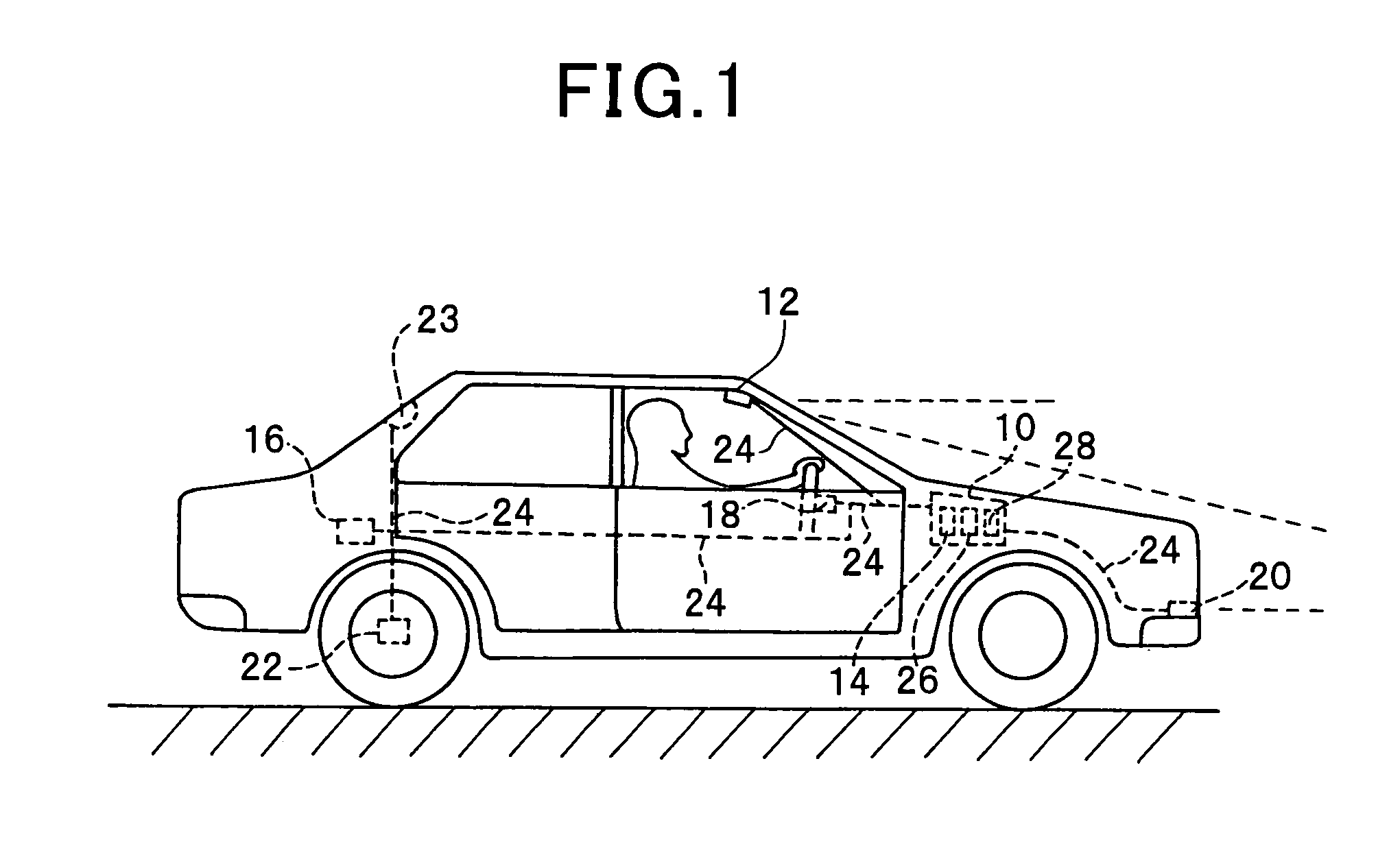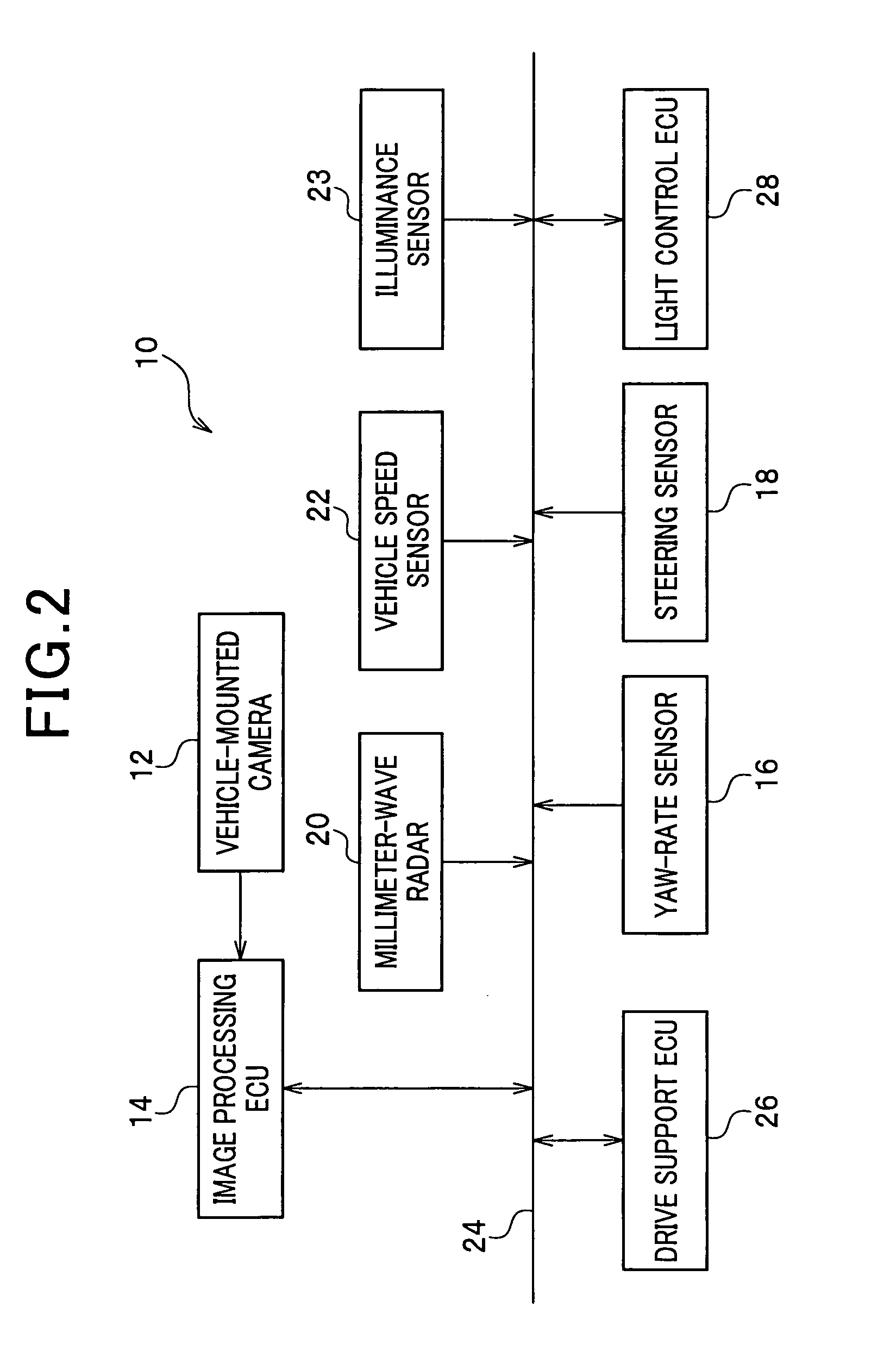Apparatus for determining the presence of fog using image obtained by vehicle-mounted imaging device
a vehicle-mounted imaging and fog detection technology, applied in scene recognition, television systems, instruments, etc., can solve the problems of human deaths and property damage, difficult accurately predicting visibility conditions, and inconvenient use, so as to reduce the error in determining whether or not fog is present, the effect of improving the accuracy of determination and reducing the value of luminan
- Summary
- Abstract
- Description
- Claims
- Application Information
AI Technical Summary
Benefits of technology
Problems solved by technology
Method used
Image
Examples
first embodiment
[0071]Referring to FIGS. 1 to 24, an apparatus according to a first embodiment of the present invention, which determines the presence of an element interfering with the visibility of a frontal view of an operator in an vehicle in an environmental atmosphere ahead of the vehicle equipped with the apparatus in the daytime, will be described below in detail.
[0072]FIG. 1 is a schematic representation of a vehicle equipped with the apparatus 10 according to the first embodiment of the present invention.
[0073]The apparatus 10 is installed in the vehicle. The presence of an element such as fog leads to poor visibility of a road scene of an operator of the vehicle. Fog is an accumulation of water droplet or ice crystal fines accompanied by water-saturated fine particles that acts to reduce visibility. Thus fog's composition is identical to that of a cloud. In the presence of fog, visible light having a wavelength ranged between 400 and 700 nanometers must be propagated within an aerosol th...
second embodiment
[0159]Referring to FIGS. 25 to 28, a second embodiment of the present invention will be explained. The mechanical constituents of the second embodiment are the same members to those of the first embodiment, but the control operations of this embodiment are different from those of the first embodiment.
[0160]FIG. 25 is a block diagram showing a structure of a vehicle-mounted apparatus 14A according to the second embodiment of the present invention.
[0161]In the apparatus 14A, the spatial frequency analyzing block 14d in the first embodiment is replaced with an edge intensity analyzing block 14d′.
[0162]The edge intensity analysis is one of the methods for calculating a total edge intensity of an image. An individual edge intensity of the corresponding pixel in the image can be obtained by a differential calculus along a vertical or horizontal direction in the image.
[0163]It should be noted that in the edge intensity analysis, the degree of the discontinuities in a sweep-line can not af...
third embodiment
[0177]Referring to FIG. 29, a third embodiment of the present invention will be explained. The mechanical constituents of the third embodiment are the same members to those of the first and second embodiments, but the control operations of this embodiment are different from those of the first and second embodiments.
[0178]In this embodiment, the masking operation in step S200 in FIG. 4 is different with the previous embodiments. Therefore, the structure of the apparatus 10 is the same one with either that of the first embodiment shown in FIG. 3 or that of the second embodiment shown in FIG. 25.
[0179]Referring to FIG. 29, the masking operation according to this embodiment will be explained in detail.
[0180]FIG. 29 is a flowchart showing a detail of a masking operation in which pictures within the image having possibility to cause noises during image processing for determining the presence of fog will be removed in step S200 in FIG. 4.
[0181]The masking operation is started in step S210 ...
PUM
 Login to View More
Login to View More Abstract
Description
Claims
Application Information
 Login to View More
Login to View More - R&D
- Intellectual Property
- Life Sciences
- Materials
- Tech Scout
- Unparalleled Data Quality
- Higher Quality Content
- 60% Fewer Hallucinations
Browse by: Latest US Patents, China's latest patents, Technical Efficacy Thesaurus, Application Domain, Technology Topic, Popular Technical Reports.
© 2025 PatSnap. All rights reserved.Legal|Privacy policy|Modern Slavery Act Transparency Statement|Sitemap|About US| Contact US: help@patsnap.com



